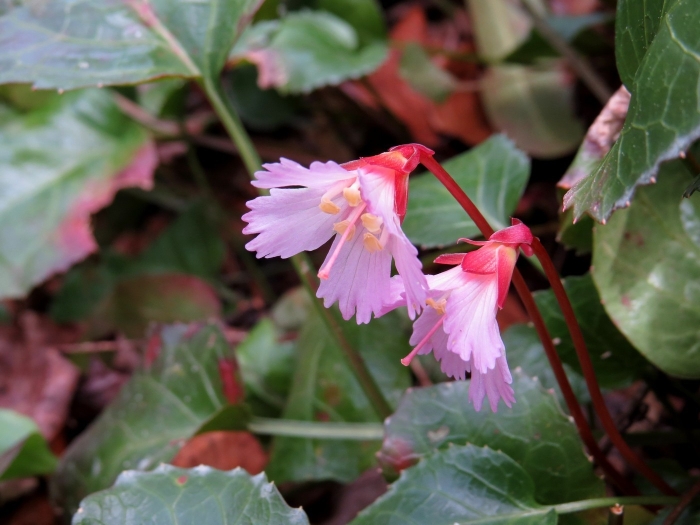Oconee Bells
(Shortia galacifolia)
Oconee Bells (Shortia galacifolia)
/
/

Evan M. Raskin
CC BY 4.0
Image By:
Evan M. Raskin
Recorded By:
Copyright:
CC BY 4.0
Copyright Notice:
Photo by: Evan M. Raskin | License Type: CC BY 4.0 | License URL: http://creativecommons.org/licenses/by/4.0/ | Rights Holder: Evan M. Raskin | Publisher: iNaturalist | Date Created: 2018-04-01T13:19:40-07:00 |

























Estimated Native Range
Summary
Shortia galacifolia, commonly known as Oconee bells, is a perennial herb native to the moist, humus-rich soils of cool, shaded slopes and stream banks in the southern Appalachian Mountains, particularly in the tri-state border region of Georgia, North Carolina, and South Carolina. It is often found in the understory of mixed deciduous and evergreen forests, where it forms dense mats. This plant typically grows to a height of 3-6 inches (7.5-15 cm) with a similar spread. The leaves are evergreen, glossy, and round to heart-shaped, providing year-round interest.
Oconee bells bloom in late March to May, producing delicate, nodding, creamy-white flowers with a yellow center, which are quite showy despite the plant’s rarity. The flowers are followed by seed capsules that mature in late July to early August. In cultivation, Oconee bells are valued for their attractive foliage and spring flowers, and they are used in shade gardens, woodland gardens, and as ground cover. They require consistently moist, well-drained, acidic soil and thrive in part shade, with a few hours of bright light daily. While not commonly available due to its rarity, it is sometimes cultivated by specialty native plant nurseries. Care should be taken to avoid overwatering and to protect it from intense midday sun. Potential problems include root rot in poorly drained soils and leaf spot diseases.CC BY-SA 4.0
Oconee bells bloom in late March to May, producing delicate, nodding, creamy-white flowers with a yellow center, which are quite showy despite the plant’s rarity. The flowers are followed by seed capsules that mature in late July to early August. In cultivation, Oconee bells are valued for their attractive foliage and spring flowers, and they are used in shade gardens, woodland gardens, and as ground cover. They require consistently moist, well-drained, acidic soil and thrive in part shade, with a few hours of bright light daily. While not commonly available due to its rarity, it is sometimes cultivated by specialty native plant nurseries. Care should be taken to avoid overwatering and to protect it from intense midday sun. Potential problems include root rot in poorly drained soils and leaf spot diseases.CC BY-SA 4.0
Plant Description
- Plant Type: Shrub, Herb
- Height: 0.3-0.6 feet
- Width: 0.5-1 feet
- Growth Rate: Slow
- Flower Color: White, Pink
- Flowering Season: Spring
- Leaf Retention: Evergreen
Growth Requirements
- Sun: Part Shade, Full Shade
- Water: Medium
- Drainage: Medium, Slow
Common Uses
Border Plant, Groundcover, Low Maintenance, Water Garden
Natural Habitat
Moist, humus-rich soils of cool, shaded slopes and stream banks in the understory of mixed deciduous and evergreen forests in the southern Appalachian Mountains
Other Names
Common Names: Heartleaf, Shortia, Galax-leaf Shortia
Scientific Names: , Shortia galacifolia, Sherwoodia galacifolia,
GBIF Accepted Name: